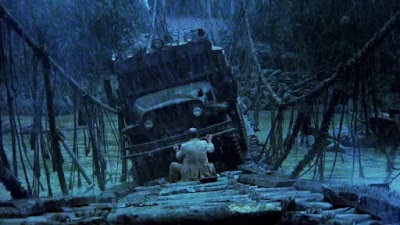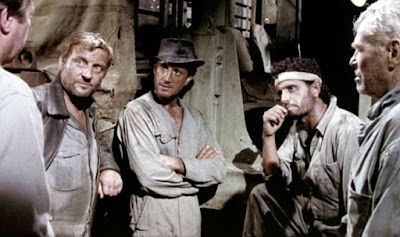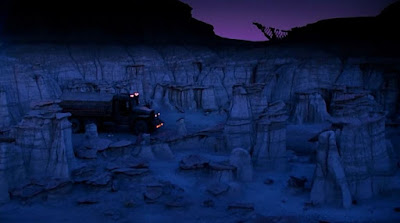 |
| Sorcerer (Directed by William Friedkin) |
Born in Chicago in 1935 William Friedkin began his career as a television documentary maker in the 1960s. His first feature film in 1965 was Good Times a vehicle for the pop duo Sonny and Cher followed by an adaptation of Harold Pinter’s play The Birthday Party (1968). The Night They Raided Minsky’s was a comedy about an innocent Amish girl who becomes a burlesque dancer in 1920s New York. Friedkin received favourable reviews for 1970’s The Boys in the Band, a landmark drama about gay life adapted from Mart Crowley’s play. It was Friedkin’s next film, The French Connection (1971), however, that brought him into the league of major directors. Based on a true crime book by Robin Moore about two narcotics detectives on the trail of international heroin traffickers, the film was a huge critical and financial success. It was noted for its tense action sequences which included a famous chase under an elevated train. The French Connection is a clever combination of reality and dramatic licence, Friedkin skilfully blending the film’s strict crime reportage background with the script’s imaginative twists. Friedkin’s hand-held documentary technique suits the picture’s gritty verite: an innovative move for a major studio feature at the time. Friedkin was nominated for an Academy Award for directing, and the film was nominated for four other Oscars, including best picture and best actor (Gene Hackman).
Friedkin next turned his attention to William Peter Blatty’s best selling novel The Exorcist. An account of demonic possession that centres on a young girl Regan (Linda Blair) the film generated much controversy upon its release in 1973, becoming one of the highest-grossing pictures of all time and receiving ten Academy Award nominations, including one for best director. As with the case with The French Connection, Friedkin relied on his documentary background to create a gritty, visceral, environment, from frozen bedrooms to green vomit spewing from the mouth of a child, grotesque devils manifest in brief subconscious interludes, others in elaborate tableaus. Made without the use of digital special effects or computer animation, The Exorcist owes much of its power to shock from its creative use of light, angles, make up, and clever illusion techniques.
The film’s supernatural material is cleverly balanced with its feel for documentary realism. Whereas a typical horror film would rely on quick cuts and shocks, The Exorcist uses long takes shot without a soundtrack. Additionally, its imagery has a strong resemblance to classical cinema tropes rather than to standard horror entertainment. It is a film that is not afraid to tackle theological subjects such as the existence of evil and the nature of religious faith, aiming for more than shock effects. There is also the persistent suggestion in both the novel and film that Regan’s transformation is the result of a mental illness or hysteria, possibly triggered by ambivalent feelings about her parents’ divorce, resentment over her mother’s emphasis on her career, love life, and other factors, combined with the onset of puberty. While many of these answers could be diversions, perhaps part of the demon’s tactic of sowing doubt and confusion, a good deal of this information also seems convincing. Indeed, Karras, a psychiatrist as well as a priest, believes in the psychological explanation throughout most of the story, until far into the final exorcism scene. Initially persuaded that Regan is not possessed, Karras views exorcism simply as a method of ‘countering suggestion’. Much of the film’s power lies in the film’s ambiguities, for example, about the origin and purpose of Regan’s possession, the exact nature of Karras’ faith crisis, and, significantly, Karras’ eventual fate.
Friedkin’s career stalled after the phenomenal success of The French Connection and The Exorcist. Sorcerer (1977), which took several years to finish due to the difficult and costly on-location shooting in Central America’s jungles, was at the time, a critical and financial failure. Friedkin had a minor comeback with 1978’s The Brink’s Job, a caper film starring Peter Falk, Peter Boyle, and Gena Rowlands. Friedkin’s subsequent picture, Cruising (1980), starring Al Pacino as a sexually conflicted policeman who goes undercover in New York City’s gay community, offers a prescient unwavering look at a taboo subculture. Friedkin followed the underwhelming comedy Deal of the Century (1983), starring Chevy Chase as an international weapons trader, with To Live and Die in Los Angeles (1985) a tough thriller about federal agents pursuing a counterfeiting ring which received widespread acclaim. It failed to rehabilitate Friedkin’s fortunes, however, despite William Petersen and Willem Dafoe delivering strong performances.
Amongst Friedkin’s later films, Rules of Engagement (2000), a military thriller starring Samuel L. Jackson, Tommy Lee Jones, Guy Pearce, and Ben Kingsley; The Hunted (2003), a crime drama starring Tommy Lee Jones as a police detective on the trail of a serial killer (Benicio Del Toro); and Bug (2006), an adaptation of Tracy Letts’ play about the mental breakdown of an ex-soldier, all stand out. Friedkin adapted another Letts play, Killer Joe, in 2011; the film follows a heroin dealer who employs a contract killer (Matthew McConaughey) to assassinate his mother in exchange for a life insurance payout. Friedkin latterly returned to the theme of exorcism in the documentary The Devil and Father Amorth (2017), which chronicled the last case of Rome’s main exorcist.
Also in 2017, there was a 40th anniversary rerelease of Sorcerer which led to a reappraisal of a film that was a notable personal project for Friedkin. Ostensibly a remake of Clouzot’s famous film The Wages of Fear, Friedkin’s version drew more directly from Georges Arnaud’s 1950 novel. Sorcerer is a singular, dark, and pessimistic film, starting out slowly, almost casually, it defies the conventional action movie narrative and sets up four different protagonists in four different situations, each introduced in a drawn out background: New Jersey gangster Scanlon (Roy Scheider), corrupt Parisian businessman Manzon (Bruno Cremer), Mexican hitman Nilo (Francisco Rabal), and Middle Eastern terrorist Kassem (Amidou). They all need to vanish and hide for a time for personal reasons. The background portion of Scanlon is itself a brilliantly tense sequence in which he robs a church during a wedding ceremony. Hiding in a deprived South American oil town, where each has a reason to avoid the past, boredom and a chance to escape leads the feuding quartet to accept a deal to transport hazardous explosives by truck to the site of a raging oil-well fire through difficult terrain.
Now considered one of Friedkin’s finest achievements, it’s a gritty, gripping tale about the corruption of money and oil, destiny and the inevitability of death, as these four desperate men undertake a perilous journey in search of redemption. The suspenseful and perilous bridge passage, as well as Roy Scheider’s desert hallucination/breakdown scene, stand out. It is a film that transcends its original filmic source owing much of its themes and style to other notable cinematic predecessors, in particular the films of John Huston and Werner Herzog. Filming was plagued by logistical and budgetary difficulties while, on release, the popularity of Star Wars obscured it. Still, its raw nihilism makes it a more fascinating version than Clouzot’s original. Friedkin envisioned a “hell on earth” and with the sheer audacity of its telling, it certainly delivers on that promise. What differentiates Sorcerer from its predecessor is Friedkin’s preference for the visual over spoken discourse and as a purely cinematic evocation, itself a form of joy, it revels in its own spectacle amidst the almost cosmic despair on show.
In the following excerpt from an interview with The Dissolve from 2014, William Friedkin discusses Sorcerer, his career, and fate.
The Dissolve: Coming off The French Connection and The Exorcist, you could have made just about any movie you wanted to. What grabbed you about Sorcerer?
Friedkin: I wanted to make an action-adventure film that had a more profound meaning, like the mystery of fate, and that’s what Sorcerer’s about. It’s about the mystery of fate, and purgatory, and redemption, and in contemporary terms. I felt that the story embodied in The Wages Of Fear, the French novel and the film, fit that template very clearly. I wanted to do a version of it, in the same way that if someone does a version of Hamlet on the stage, it’s not a remake, it’s a new production, a new interpretation. And that’s how I did it: I changed all the characters, I changed all the incidents, but kept the spine of the original framework of the story, because I thought it was timeless. I had no interest in doing a remake or a shot-for-shot or anything like that, but I love the premise, the essential premise of four strangers who mostly didn’t like one another, delivering a load of dynamite, and they either had to cooperate or die. And that seemed to me like a metaphor for the world situation—even more so today.
The Dissolve: The relationships between your characters are largely sketched out nonverbally.
Friedkin: They’re wary of each other. And that’s the way the countries of the world are to this day. They’re all wary of each other. And yet they either have to find a way to cooperate, or blow up together.
The Dissolve: You mentioned redemption. Is that ever a possibility for these characters, or are they doomed from the beginning?
Friedkin: I don’t know that actual redemption is possible for them. I think that’s more or less in the eye of the beholder. The overriding idea is that nobody, none of us, has any control over how we came into this world, or how we’re going to leave it. The film is about the mystery of fate. Eventually, it seems to me, that they don’t receive redemption, but punishment. They don’t make it no matter what the effort.
The Dissolve: Fiction usually tells us the opposite, which is one of the reasons it’s more satisfying than real life: Bad things happen to you because you did something bad, or because you angered the gods.
Friedkin: That’s if you have a certain fate. But the fact is, nobody in the history of the world, whether it be Jesus or Hitler, has any control of how they came into this world, what personality they were given, what events occur in their lives, and they have nothing at all to say about how they’re leaving the world. For a long time, it looked as though Jesus was going to die in obscurity, and now look. For a long time, it looked as though Hitler was well on his way to conquering the given world at that time, and now look. Nobody, not the historical and mythic figures of history, had anything to say about their birth, or death, or time of death, or anything else, unless you commit suicide, which is a kind of complete loss of fate. The ending is the same for all of us.
The Dissolve: As you mentioned, you reinvented the characters from the novel. Why did you choose to make one of them a terrorist, and set his prologue in Jerusalem?
Friedkin: It was just an idea that came up between the writer, Wally Green, and I. We had no intention of copying those characters, but we came up with these guys who are outside the law to one degree or another: One guy was a white-collar criminal, the other guy was the wheelman for a stick-up gang, the other guy was an Arab terrorist, and the fourth guy was a hired assassin. We decided, at a time when the zeitgeist was going completely the other way, toward Star Wars and superheroes, we decided to not make these characters superheroes, not have them survive because they had supernatural powers. We decided to make them be very flawed men, which is, of course, how they would wind up in a purgatory like that to begin with. The most interesting part of a journey is how the traveler came to the starting point in the first place. How the hell did they get there, and where were they going?
The Dissolve: People remember The Wages Of Fear as a movie about men driving a truck, but your characters don’t start their engines until Sorcerer is more than half over.
Friedkin: Well, that doesn’t bother me, because in the time I made it, that was never a consideration. Audiences understood the slow build of story that created suspense. Why should I drop them in the truck immediately and have to invent 10 times as many incidents? I was more interested in suggesting their characters and how they got to that place, what I just said to you: The interesting thing to me was what got them to that starting point in the first place. And then, you kind of had a clue on how they might react. Often it was a false clue. If you were making the film today, you’d of course have to get them in the truck in the first reel. Audiences are less tolerant of slow build. With all the superhero pictures, it’s rock ’em, sock ’em from the credits.
The Dissolve: How did you conceive the journey of Roy Scheider’s character?
Friedkin: That’s open-ended. The film begins in mystery and ends in mystery. There’s a savage journey in between. I don’t know how Scheider’s character ends up, because I didn’t load the deck. He’s in that bar where he’s a hero to the people in the bar. There are armed men in the bar, there’s a couple of police officers from the town, there’s the guys from the oil company, and there’s everybody else who’s around the bar inside and outside, who might be able to foil the two guys who come after him or not. It’s an ambiguous ending in that sense. [Spoilers ahead.]
The Dissolve: You hear the one shot at the end—
Friedkin: Do you know what that shot is? It’s actually a backfire of a vehicle that goes by. But of course, people think it’s a gunshot.
The Dissolve: It’s awfully muffled; you can’t tell if it’s part of the soundtrack or the score. But it seems to represent that.
Friedkin: There’s the hint of a gunshot. I actually used a backfire of a diesel engine.
The Dissolve: So you leave it up to us.
Friedkin: It is totally up to the audience. I wouldn’t even hazard a guess as to whether he gets out of there. There is a small sense of hope, because he is given the letter to the French guy’s wife by the oil-company executive, and you kind of get the feeling he might go to see her, and she’s a very bright and attractive woman, and who knows! He hears nostalgic music from the jukebox which overtakes him, as music often does, and he’s kind of lulled into what could be a false sense of security. There is some hope offered for the possibility of his meeting Victor’s wife. [End spoilers.]
The Dissolve: It’s a great performance, even though Scheider wasn’t your first choice.
Friedkin: I think he was great, though. I had other choices, but now that I’ve lived with the picture for 37 years, I think he’s perfect.
The Dissolve: It’s great that he’s not especially heroic. When he yells out, “We’re sitting on double shares!” he sounds like Fred C. Dobbs in The Treasure Of The Sierra Madre.
Friedkin: It is a Fred C. Dobbs moment. Fred C. Dobbs is one of my favorite characters in film, and there’s a lot of him in Roy’s performance.
The Dissolve: Sorcerer would have been helped at the box office by having a bigger star in the lead, but it works for the character that he isn’t a hero.
Friedkin:I don’t know about the stars, you’re probably right. But the three people who were in Star Wars weren’t stars either, then. It was a concept that prevailed. Star Wars changed the zeitgeist of American film forever. If Star Wars had failed, you wouldn’t have had 90 percent of the films that are produced in Hollywood today.
The Dissolve: So after Star Wars changed everything and Sorcerer flopped, where did you see yourself in the grand scheme of things?
Friedkin: I just realized what I told you, that the direction of American film had gone in the opposite direction from the film I had just made. It happens. The moving finger writes, and having writ, moves on.
The Dissolve: That’s a very appropriate epigraph.
Friedkin: It is. The rest of that is “nor all thy piety nor wit… can cancel out a word of it.” That’s what happens. Star Wars came along and changed what we think of as a movie in America.
The Dissolve: In a way, that’s what Sorcerer is about. It would have seemed almost off if it were a big hit.
Friedkin: Well, it isn’t to me so much about failure as striving. Striving against one’s fate.
The Dissolve: There’s a Sisyphean quality to it. Scheider’s character realizes early on that there are two trucks because they expect one won’t make it.
Friedkin: Right. From beginning to end, it’s an impossible journey.
Full interview here










